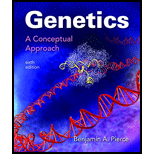
a.
To propose:
The hypothesis to explain the inheritance of kitey, black, and red feather color in pegion.
a.
Explanation of Solution
To investigate the relation between kitey, black and red feather color, crosses were made which are given in following table:
| Cross | Offspring |
| 16 kitey, 5 black, 3 red | |
| 6 kitey, 7 black | |
| 18 red . 9 kitey, 6 black |
Feather color in pigeons are determined by four alleles:
Cross between two pegions carrying kitey
|
(Kitey) |
(Red) | |
|
(Kitey) |
(Black) |
Total number of offsprings observed in the cross
Cross between two pegions carrying black kitey phenotype:
|
(Kitey) |
(Black) | |
|
(Kitey) |
(Black) |
Total number of offspring observed in the cross
Cross between two pegions carrying red and kitey phenotype;
|
(Red) |
(Red) | |
|
(Kitey) |
(Black) |
Total number of offspring observed in the cross
On the basis of the results obtained from the crosses , it can be hypothesized that “
b.
To test:
The hypothesis for each of the preceding crosses using a chi square test.
b.
Explanation of Solution
To investigate the relation between kitey, black and red feather color, crosses were made which are given in the following table:
| Cross | Offspring |
| 16 kitey, 5 black, 3 red | |
| 6 kitey, 7 black | |
| 18 red . 9 kitey, 6 black |
Feather color in pigeons are determined by four alleles:
Cross between two pegions carrying kitey phenotype;
|
Kitey |
Red | |
|
Kitey |
Black |
Total number of offspring expected in the cross
Total number of offspring produced in the cross
To compare the observed number of progenies with the expected number of progenies in cross
The difference between expected number of progenies and observed number of progenies in
Cross between two pegions carrying black kitey phenotype:
|
(Kitey) |
(Black) | |
|
(Kitey) |
(Black) |
Total number of offspring expected in the cross
Total number of offspring produced in the cross
To compare observed number of progenies with expected number of progenies in cross
The difference between expected number of progenies and observed number of progenies in
Cross between two pegions carrying red and kitey phenotype;
|
(Red) |
(Red) | |
|
(Kitey) |
(Black) |
Total number of offspring expected in the cross
Total number of offspring observed in the cross
To compare the observed number of progenies with the expected number of progenies in cross
The difference between expected number of progenies and observed number of progenies in
Considering the crosses and their results, it can be hypothesized that
Want to see more full solutions like this?
Chapter 5 Solutions
Genetics: A Conceptual Approach
 Human Anatomy & Physiology (11th Edition)BiologyISBN:9780134580999Author:Elaine N. Marieb, Katja N. HoehnPublisher:PEARSON
Human Anatomy & Physiology (11th Edition)BiologyISBN:9780134580999Author:Elaine N. Marieb, Katja N. HoehnPublisher:PEARSON Biology 2eBiologyISBN:9781947172517Author:Matthew Douglas, Jung Choi, Mary Ann ClarkPublisher:OpenStax
Biology 2eBiologyISBN:9781947172517Author:Matthew Douglas, Jung Choi, Mary Ann ClarkPublisher:OpenStax Anatomy & PhysiologyBiologyISBN:9781259398629Author:McKinley, Michael P., O'loughlin, Valerie Dean, Bidle, Theresa StouterPublisher:Mcgraw Hill Education,
Anatomy & PhysiologyBiologyISBN:9781259398629Author:McKinley, Michael P., O'loughlin, Valerie Dean, Bidle, Theresa StouterPublisher:Mcgraw Hill Education, Molecular Biology of the Cell (Sixth Edition)BiologyISBN:9780815344322Author:Bruce Alberts, Alexander D. Johnson, Julian Lewis, David Morgan, Martin Raff, Keith Roberts, Peter WalterPublisher:W. W. Norton & Company
Molecular Biology of the Cell (Sixth Edition)BiologyISBN:9780815344322Author:Bruce Alberts, Alexander D. Johnson, Julian Lewis, David Morgan, Martin Raff, Keith Roberts, Peter WalterPublisher:W. W. Norton & Company Laboratory Manual For Human Anatomy & PhysiologyBiologyISBN:9781260159363Author:Martin, Terry R., Prentice-craver, CynthiaPublisher:McGraw-Hill Publishing Co.
Laboratory Manual For Human Anatomy & PhysiologyBiologyISBN:9781260159363Author:Martin, Terry R., Prentice-craver, CynthiaPublisher:McGraw-Hill Publishing Co. Inquiry Into Life (16th Edition)BiologyISBN:9781260231700Author:Sylvia S. Mader, Michael WindelspechtPublisher:McGraw Hill Education
Inquiry Into Life (16th Edition)BiologyISBN:9781260231700Author:Sylvia S. Mader, Michael WindelspechtPublisher:McGraw Hill Education





